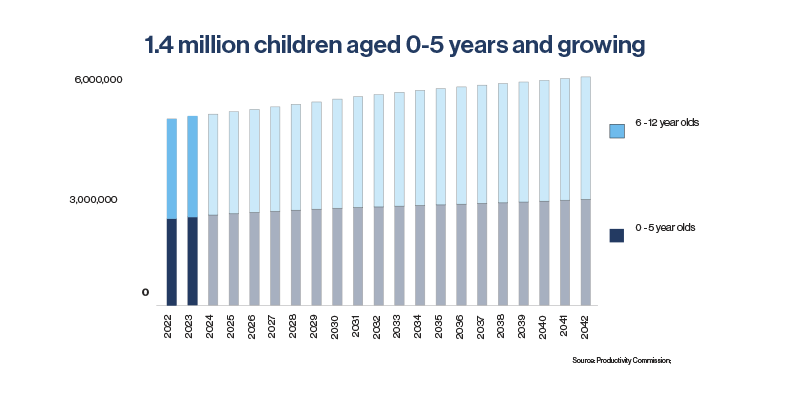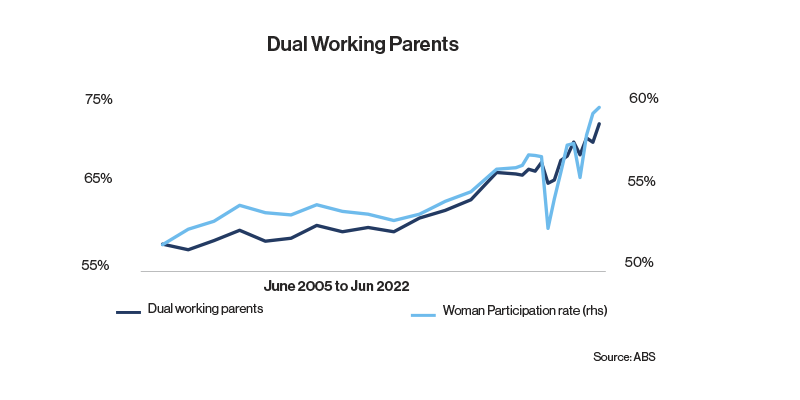)
The Future of Childcare: Trends and Projections
Introduction
The childcare industry is undergoing significant transformation, driven by demographic shifts, evolving employment trends, and increasing recognition of the importance of early childhood education. This article delves into the future of childcare, exploring key trends and projections that will shape the industry in the coming decades. From rising child populations to growing investment opportunities, understanding these dynamics is crucial for stakeholders aiming to navigate and capitalise on the evolving market landscape.
Child Population Growth
The future of childcare is intrinsically linked to demographic trends, particularly the anticipated rise in the child population. Forecasts suggest a 24% increase in the child population from 2022 to 2042, underscoring a substantial and sustained demand for childcare services. This growth is influenced by various factors, including higher birth rates, improved healthcare leading to lower infant mortality, and policies encouraging family expansion. Such a significant rise necessitates an expansion of childcare facilities and services to accommodate the increasing number of children requiring care and education.
This projected growth presents both challenges and opportunities. On one hand, the existing childcare infrastructure may struggle to meet the increased demand, leading to overcrowding and compromised service quality. On the other hand, this scenario offers a ripe opportunity for investment in new childcare centres and services, encouraging innovation in the sector. Entrepreneurs and established providers alike will need to focus on scalable solutions, leveraging technology and novel educational methodologies to cater to this growing demographic efficiently.

Employment Trends
A pivotal factor influencing the future of childcare is the continued increase in dual working parents and the rising employment rate among women. Over recent decades, societal norms around work and family have shifted significantly, with more families relying on dual incomes to maintain their standard of living. This trend is set to continue, further driving the demand for reliable and high-quality childcare services.
The modern workforce is characterised by greater gender equality, with more women pursuing careers and contributing to the economic fabric. This shift not only increases the demand for childcare but also emphasises the need for flexible, affordable, and accessible services that can accommodate diverse working schedules. Employers are increasingly recognising the importance of providing childcare support to attract and retain talent, leading to the integration of childcare benefits into employee welfare programs.
Innovative solutions such as employer-sponsored childcare, flexible working hours, and remote work options are likely to become more prevalent, aligning with the needs of working parents. Additionally, the gig economy and freelance work arrangements further necessitate adaptable childcare solutions that cater to non-traditional work hours. The childcare industry must evolve to meet these demands, offering flexible, high-quality services that support the work-life balance of modern families.

Future Investment Opportunities
The growing demand for childcare services, fueled by demographic and employment trends, presents significant investment opportunities. As the need for childcare outstrips supply, there is a clear market gap that investors can exploit. Establishing new childcare centres, expanding existing facilities, and innovating service delivery models are key areas where investment can yield substantial returns.
The integration of technology into childcare is another promising avenue for investment. Digital platforms that facilitate parent-caregiver communication, manage administrative tasks, and enhance educational experiences are gaining traction. Ed-tech solutions tailored to early childhood education can improve learning outcomes, making them attractive to both parents and investors. Additionally, incorporating sustainability into childcare operations, such as eco-friendly facilities and practices, can appeal to environmentally conscious parents and provide a competitive edge.
Government policies and incentives also play a crucial role in shaping investment opportunities in the childcare sector. Subsidies, tax benefits, and grants aimed at expanding access to quality childcare can significantly enhance the financial viability of new ventures. Investors must stay informed about regulatory changes and leverage these incentives to maximise their investment potential.
Conclusion
The childcare industry is poised for sustained growth and continuous evolution, driven by demographic trends, changing employment patterns, and increasing recognition of the importance of early childhood education. The anticipated rise in the child population and the growing participation of women in the workforce will amplify the demand for high-quality, flexible, and accessible childcare services. These dynamics create opportunities for investment, innovation, and expansion in the sector.
As the childcare industry adapts to these trends, stakeholders must remain agile and forward-thinking, embracing new technologies, service models, and policy incentives. By doing so, they can ensure they are well-positioned to meet the evolving needs of families and capitalise on the promising growth prospects of the childcare sector. The future of childcare is not only about meeting demand but also about enriching the early childhood experience, setting the stage for the next generation's success.
FAQs
What factors are driving the increase in the child population?
The projected increase in the child population is driven by higher birth rates, improved healthcare reducing infant mortality, and supportive family policies.
How is the rise in dual working parents affecting childcare demand?
The increase in dual working parents is boosting demand for reliable, flexible, and high-quality childcare services to support families juggling work and childcare responsibilities.
What investment opportunities exist in the childcare sector?
Investment opportunities include establishing new childcare centres, expanding existing facilities, integrating technology into childcare services, and adopting sustainable practices.
How can technology enhance childcare services?
Technology can streamline administrative tasks, facilitate parent-caregiver communication, and enhance educational experiences through digital learning platforms and interactive tools.
What role do government policies play in the childcare industry?
Government policies, such as subsidies, tax benefits, and grants, support the expansion of access to quality childcare and can enhance the financial viability of new ventures.
Why is early childhood education important for the future of childcare?
Early childhood education is crucial for cognitive and social development, preparing children for academic success and lifelong learning. It is increasingly recognised as a vital component of childcare services.


)
)
)
)
)
)
)
)
)
)
)
)
